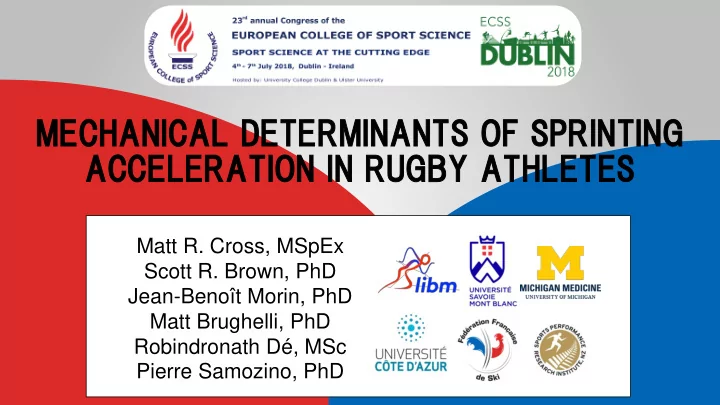

ME MECH CHANI NICA CAL DE DETER ERMI MINA NANT NTS S OF OF S SPR PRINT NTING NG ACC CCEL ELER ERATION N IN N RUG UGBY BY ATHL HLET ETES ES Matt R. Cross, MSpEx Scott R. Brown, PhD Jean-Benoît Morin, PhD Matt Brughelli, PhD Robindronath Dé, MSc Pierre Samozino, PhD
What determines acceleration performance? F h vs. Time 𝑄 = 𝐺 ∙ 𝑤 Some preliminary evidence: • General theory of force dominant profile being ? 5 m advantageous over ‘short distances’ • Some information of velocity dominance for longer 10 m distances (40-100 m) (Morin et al. 2012, 2016; Rabita et al. 2015) 20 m (+) • Limited information over short distances and acceleration dominant (e.g. rugby) athletes
What determines ‘common’ split times? ‘Short’ ‘Long’ Sprint distance 5 m sprint 30 sprint + TRANSFER TRANSFER Power Force Velocity
Approach Scott R. Brown @scottiehype League Sevens Union N =19 N =46 N =173 All levels (club → elite) 238 athletes 5 seasons 30 – 45 m maximal sprints Power Force 1 – 3 trials (~5 mins rest) Field conditions (grass / turf) Velocity
What mechanical capacities determine sprint performance [in rugby athletes]? Project aims 1. Clarify horizontal force expression underlining sprint performance at various distances; 2. Determine normative values and variables tbd correlated to Rugby player level.
Analysis + statistics Mechanical data Max Force • Macro. approach (Samozino et al. 2016) Max Power ‘ F @ low v ’ • Fv & Pv = linear & polynomial fits ‘Opt. FV output’ • F 0 v 0 P max & S Fv calculated P max F 0 Split times • 5, 10, 20, 30 m Power Force Statistics • ≥2 trials averaged ▼ error (Hopkins et al. 2010) v 0 • Stepwise regression models: 0 0 Velocity 1) P max + S Fv → split times Max Velocity 2) F 0 v 0 → split times ‘ v @ low F ’
Results Stepwise regression results for mechanical variables on split times Model 1: P max and S Fv P max Split 5 m 10 m 20 m 30 m explains (1) P max .947 .980 .950 .881 very large (2) S Fv .037 .002 .031 .098 level of variance .983 (1,2) .982 (1,2) .981 (1,2) .980 (1,2) Full model Full models (>88%) -.89 (1) ; .21 (2) -.97 (1) ; .04 (2) -1.05 (1) ; -.19 (2) -1.07 (1) ; -.34 (2) STD coeff. explain >98% of Model 2: F 0 and v 0 variance in performance Split 5 m 10 m 20 m 30 m Primary F 0 (1) .895 .789 .353 .226 predictors ‘switch’ (2) v 0 .094 .199 .635 .761 between 10 .989 (1,2) .988 (1,2) .988 (2,1) .986 (2,1) Full model and 20 m -.87 (1) ; -.32 (2) -.78 (1) ; -.46 (2) -.65 (2) ; -.61 (1) -.75 (2) ; -.49 (1) STD coeff. All correlations P <0.001. Step order of entry into full model denoted by superscript parenthesis.
Summary points • P max strongly determines performance, but the way it is developed still matters (degree requires more research and investigation) • Cross-over of F/v demands at between 10 and 20 m • All factors significantly** improved models (even max. velocity @ 5) P max + S Fv F 0 + v 0 1 1 0.8 0.8 Correlation ( R 2 ) Correlation ( R 2 ) 0.6 0.6 0.4 0.4 0.2 0.2 0 0 0 5 10 15 20 25 30 0 5 10 15 20 25 30 Sprint distance (m) Sprint distance (m)
Practical applications Proposed ‘hierarchy’ of training attention • Lower level athletes benefit from generalised approach (‘tooth - paste analogy’) • Focus on training at P max may provide biggest ‘return’ on investment • Higher level athletes might benefit from targeted development of S Fv Do these results transfer to rugby? Actual • Horizontal F/v profiles in team sports may not match what ‘optimizes’ sprinting performance F • Positional demands may dictate unique horizontal Optimal force signatures from athletes (e.g. de Lacy et al. 2017) v What is optimal? Force vs. …more research needed Velocity
Application to training Target training: Acceleration conditions • Use high resistance for ‘modelled’ using spectrum of short distances (<10 m) loading @ max (+error) • Use low resistance for ‘long F 0 P max distance’ sprinting (>20 m) ~10-20 m - Horizontal resistance + Individual specific… Horizontal power Horizontal force • Adaptations may depend on pre-training profile • ‘Force’ stimulus may improve velocity in deficient athletes 50% v Dec (& vice-versa) ~80% BM sled v 0 𝑤 𝐺 0 0 Velocity F F Sprinting acceleration Early Late v v
Thank you Matthew.Cross@univ-savoie.fr @MattCrossNZ cross.matt.r Matt_Cross2
Acknowledgements Coaches + Athletes New Zealand-France Friendship Fund Collaborators Scott R. Brown Jean-Benoît Morin Matt Brughelli Robindronath Dé Pierre Samozino
Recommend
More recommend